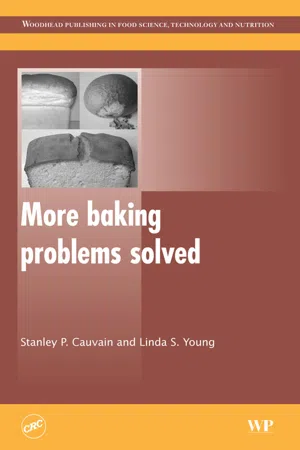Problems that show as unexpected variations in bakery product quality do occur from time to time. Often considerable time, effort and money are required to identify the causes and solutions concerned. Unexpected quality variations are not the exclusive province of any particular size of manufacturing unit: they can occur in both large and small bakeries. Nor are they exclusive to the production bakery: even the best-controlled test bakery or laboratory can experience unexpected fluctuations in product quality.
There is no magic to problem solving. It is normally achieved through critical observation, structured thought processes and access to suitable sources of information. In this chapter we offer a guide to some of the methods that might be employed when trying to solve bakery-related problems. In doing so we must recognise that baking is a complex mixture of ingredient and process interactions so that the solutions to our problems may not always be instant in nature and because ingredients and processes change, new solutions are always being discovered. The complex interactions which underpin baking dictate that there are seldom unique solutions to individual problems. In the majority of cases individual quality defects are overcome by changing a number of ingredient and process factors, some of which will be apparently unrelated, though careful study will often reveal that relationships do exist even where they are masked by more prominent effects.
1.1 How to problem solve
Successful problem solving usually requires a methodical approach. It is perfectly possible to stumble quickly on the required solution by chance but more often than not a haphazard approach to problem solving is wasteful of time, resources and money. In addition, stumbling on the solution by chance often means that the root cause of the problem remains unidentified and the opportunity is lost for the systematic assembly of information which may be valuable for solving similar problems in the future. Not all problems are solved using exactly the same approach but the critical elements of the problem-solving process are largely common.
In problem solving we normally move from the problem to the cause and finally to the corrective action. However, we must recognise that on many occasions the manifestation of a particular problem does not necessarily have a unique and identifiable cause and so there may be other intermediate steps to take into account in determining the real cause of the problem. This situation can be described schematically as follows:
Or in more simple terms as:
The basic process becomes apparent if we consider two examples of problems in bread making; the first, low bread volume, and the second, collapse of the sides of an open top pan loaf, often referred to as ‘keyholing’ (BPS, pp. 57–8).
Low bread volume
Externally we observe that the bread is smaller than we expect and this may also have led to a paler crust colour because of the poorer heat transfer to the dough surface during baking. Internally the cell structure may be more open than usual.
Since bread volume is a consequence of expansion of the dough by carbon dioxide gas from yeast fermentation and the retention of that gas within the dough matrix (Cauvain, 2007a), there are two potential primary causes of this problem – lack of gas production and lack of gas retention. To separate the two we will need more observations, and an important one will be whether the rate of expansion of the dough in the prover and oven was normal or slower than usual. If the latter was the case then the primary cause of the problem is likely to be lack of gas production, and potential contributing factors may include the following:
• yeast activity or level too low;
• lack of yeast substrate (food);
• dough temperature too low;
• proving temperature too low;
• proving time too short;
• salt level too high;
• proving temperature/time/yeast combination incorrect.
On the other hand, if the proving had been at a normal rate and there was a lack of oven spring, then this would lead us to recognise that the problem would be lack of gas retention. In this case the list of potential reasons for the problem includes:
• improver level too low;
• incorrect improver formulation;
• combination of improver and flour too weak for the breadmaking process being used;
• enzymic activity too low;
• energy input during mixing too low;
• mixing time too short;
• dough temperature too low.
Note that the ‘dough temperature’ too low appears in both lists because of its effect on yeast activity and the effectiveness of the functional ingredients in the improver, especially if ascorbic acid is used.
Keyholing (BPS, pp. 57–8)
Externally we observe there is a loss of bread shape but only at the sides of the product. Internally we may see the formation of dark-coloured, dense seams, often referred to as cores. The centre crumb may be more open than we normally expect for the product concerned.
Why has this happened? Clearly we have no problems with gas production, since there is no evidence for slow proving and the bread had good volume. We have clearly retained the carbon dioxide gas produced, otherwise the bread would have low volume as described above. In this case the over-expansion...


